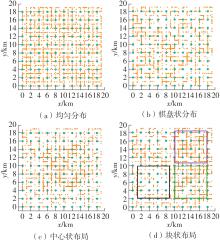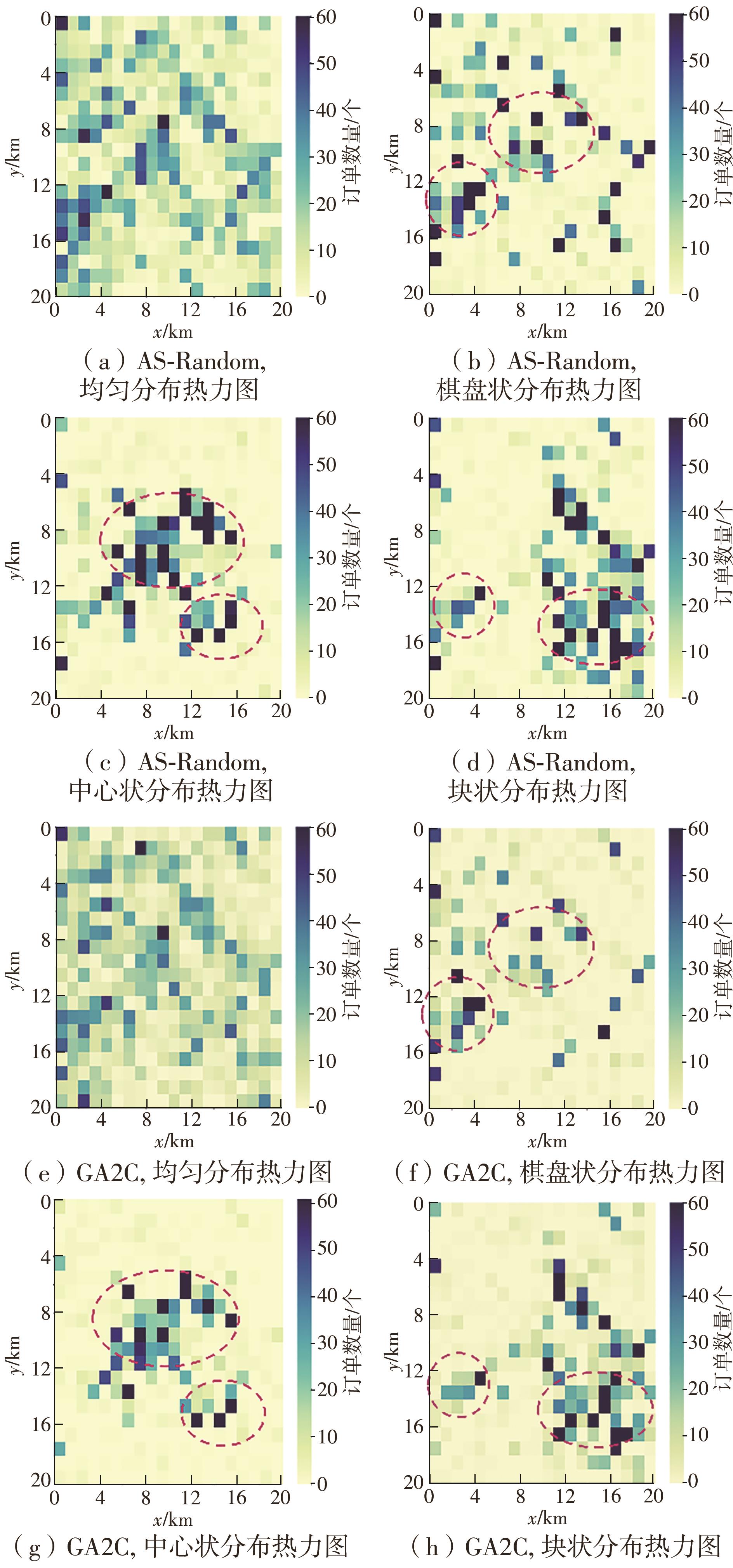Journal of South China University of Technology(Natural Science Edition) ›› 2023, Vol. 51 ›› Issue (10): 99-109.doi: 10.12141/j.issn.1000-565X.230148
Special Issue: 2023绿色智慧交通系统专辑
• Green, Intelligent Traffic System • Previous Articles Next Articles
Repositioning Strategy for Ride-Hailing Vehicles Based on Geometric Road Network Structure and Reinforcement Learning
XU Lunhui1 YU Jiaxin1 PEI Mingyang1 WU Pan2 LI Peng3
- 1.School of Civil Engineering and Transportation,South China University of Technology,Guangzhou 510640,Guangdong,China
2.School of Transportation Engineering,Chongqing Jiaotong University,Chongqing 400000,China
3.School of Automobile and Transportation,Shenzhen Polytechnic,Shenzhen 518055,Guangdong,China
-
Received:2023-03-28Online:2023-10-25Published:2023-06-05 -
Contact:裴明阳(1993-),女,博士,副教授,主要从事交通系统优化建模研究。 E-mail:mingyang@scut.edu.cn -
About author:许伦辉(1965-),男,博士,教授,主要从事智能交通系统研究。E-mail:lhxu@scut.edu.cn -
Supported by:the Basic and Applied Research Foundation of Guangdong Province(2020A1515111024)
CLC Number:
Cite this article
XU Lunhui, YU Jiaxin, PEI Mingyang, et al. Repositioning Strategy for Ride-Hailing Vehicles Based on Geometric Road Network Structure and Reinforcement Learning[J]. Journal of South China University of Technology(Natural Science Edition), 2023, 51(10): 99-109.
share this article
Table 2
Comparison of order response rate in different order requirements"
订单需求 分布 | ORR/% | R/% | |||||||
|---|---|---|---|---|---|---|---|---|---|
| 100%1) | 50%1) | 20%1) | 100%2) | 50%2) | 20%2) | 100% | 50% | 20% | |
| 均匀分布 | 93.5 | 59.7 | 36.6 | 94.6 | 60.2 | 36.9 | 1.17↑ | 0.83↑ | 0.82↑ |
| 棋盘状分布 | 73.5 | 55.4 | 38.0 | 84.2 | 63.2 | 41.8 | 14.55↑ | 14.07↑ | 10.00↑ |
| 中心状布局 | 54.8 | 41.8 | 30.7 | 58.1 | 45.1 | 32.8 | 6.02↑ | 5.98↑ | 6.84↑ |
| 块状布局 | 54.1 | 41.7 | 29.7 | 61.2 | 46.1 | 32.5 | 13.12↑ | 10.55↑ | 9.42↑ |
| 1 | XU Z T, YIN Y F, CHAO X L,et al .A generalized fluid model of ride-hailing systems[J].Transportation Research Part B:Methodological,2021,150:587-605. |
| 2 | CHENG S F, JHA S S, RAJENDRAM R .Taxis strike back:a field trial of the driver guidance system[C]∥Proceedings of the 17th International Conference on Autonomous Agents and Multi-Agent Systems.Richland:ACM,2018:577-584. |
| 3 | LEI D C, WU Y S .Order-dispatching strategy induced by optimal transport plan for an online ride-hailing system[J].Transportation Research Record,2022,2676:156-169. |
| 4 | ODA T, CARLEE J W .MOVI:a model-free approach to dynamic fleet management[C]∥Proceedings of the IEEE INFOCOM 2018-IEEE Conference on Computer Communications.New York:IEEE,2018:2708-2716. |
| 5 | 温惠英,林译峰,吴昊书,等 .基于城市道路交通环境演变的ECEA路径规划算法[J].华南理工大学学报(自然科学版),2021,49(10):1-10. |
| WEN Huiying, LIN Yifeng, WU Haoshu,et al .Extended co-evolutionary algorithm for path planning based on the urban traffic environment evolution[J].Journal of South China University of Technology (Natural Science Edition),2021,49(10):1-10. | |
| 6 | XU J, ROUHOLLAH R, LADISLAU B,et al .A taxi dispatch system based on prediction of demand and destination[J].Journal of Parallel and Distributed Computing,2021,157(11):269-279. |
| 7 | ZHANG L Y, TAO H, MIN Y,et al .A taxi order dispatch model based on combinatorial optimization[C]∥Proceedings of the 23rd ACM SIGKDD International Conference on Knowledge Discovery and Data Mining.New York:ACM,2017:2151-2159. |
| 8 | 罗瑞发,郝慧君,徐桃让,等 .考虑时延的网联车混合交通流基本图模型[J].华南理工大学学报(自然科学版),2023,51(1):106-113. |
| LUO Ruifa, HAO Huijun, XU Taorang,et al .Fundamental diagram model of mixed traffic flow of connected vehicles considering time delay[J].Journal of South China University of Technology(Natural Science Edition),2023,51(1):106-113. | |
| 9 | FEI M, HAN S, LIN S,et al .Data-driven robust taxi dispatch under demand uncertainties[J].IEEE Transactions on Control Systems Technology,2019,27(1):175-191. |
| 10 | SUTTON R, BARTO A .Reinforcement learning:an introduction[J].IEEE Transactions on Neural Networks,2015,16:285-286. |
| 11 | WEN J, ZHAO J, JAILLET P .Rebalancing shared mobility-on-demand systems:a reinforcement learning approach[C]∥2017 IEEE 20th International Conference on Intelligent Transportation Systems (ITSC).Yokohama:IEEE,2017:220-225. |
| 12 | LIU Z D, LI J Z, WU K S .Context-aware taxi dispatching at city-scale using deep reinforcement learning[J].IEEE Transactions on Intelligent Transportation Systems,2022,23:1996-2009. |
| 13 | RONG H G, ZHOU X, YANG C,et al .The rich and the poor:a Markov decision process approach to optimizing taxi driver revenue efficiency[C]∥Proceedings of the 25th ACM International on Conference on Information and Knowledge Management.New York:ACM,2016:2329-2334. |
| 14 | FENG J K, GLUZMAN M O, DAI J G .Scalable deep reinforcement learning for ride-hailing[J].IEEE Control Systems Letters,2021,5:2060-2065. |
| 15 | LIU Z D, LI J Z and WU K .Context-aware taxi dispatching at city-scale using deep reinforcement learning[J].IEEE Transactions on Intelligent Transportation Systems,2020,23(3):1996-2009. |
| 16 | LIN K X, ZHAO R Y, XU Z,et al .Efficient large-scale fleet management via multi-agent deep reinforcement learning[C]∥Proceedings of the 24th ACM SIGKDD International Conference on Knowledge Discovery and Data Mining.New York:ACM,2018:1774-1783. |
| 17 | SHOU Z Y, DI X, YE J P,et al .Optimal passenger-seeking policies on e-hailing platforms using aarkov decision process and imitation learning[J].Transportation Research Part C:Emerging Technologies,2020,111(2):91-113. |
| 18 | 王福建,程慧玲,马东方,等 .基于深度逆向强化学习的城市车辆路径链重构[J].华南理工大学学报(自然科学版),2023,51(7):120-128. |
| WANG Fujian, CHENG Huiling, MA Dongfang,et al .Urban vehicle path chain reconstruction based on deep inverse reinforcement learning[J].Journal of South China University of Technology (Natural Science Edition),2023,51(7):120-128. | |
| 19 | ZHOU M, JIN J R, ZHANG W N,et al .Multi-agent reinforcement learning for order-dispatching via order-vehicle distribution matching[C]∥Proceedings of the 28th ACM International Conference on Information and Knowledge Management.New York:ACM,2019:2645-2653. |
| 20 | TAN M .Multi-agent reinforcement learning:independent vs.cooperative agents[C]∥Proceedings of the 10th International Conference on Machine Learning.Amherst:Morgan Kaufmann Publishers Inc,1993:330-337. |
| 21 | JIAO Y, TANG X C, QIN Z W,et al .Real-world ride-hailing vehicle repositioning using deep reinforcement learning[J].Transportation Research Part C:Emerging Technologies,2021,130:103289. |
| 22 | YANG Y D, LUO R, LI M,et al .Mean field multi-agent reinforcement learning[C]∥Proceedings of the 35th International Conference on Machine Learning.Stockholm:JMLR,2018,80:5571-5580. |
| 23 | LI M, QIN Z W, JIAO Y,et al .Efficient ridesharing order dispatching with mean field multi-agent reinforcement learning[C]∥Proceeding of the World Wide Web Conference.New York:ACM,2019:983-994. |
| 24 | ZHU Z, KE J, WANG H,et al .A mean-field markov decision process model for spatial-temporal subsidies in ride-sourcing markets[J].Transportation Research Part B:Methodological,2021,150:540-565. |
| 25 | SHOU Z Y, DI X .Reward design for driver repositioning using multi-agent reinforcement learning[J].Transportation Research Part C:Emerging Technologies,2020,119:102738. |
| 26 | LOWE R, WU Y, TAMAR A,et al .Multi-agent actor-critic for mixed cooperative competitive environments[C]∥Proceedings of the 31st International Conference on Neural Information Processing Systems.New York:Curran Associates Inc,2017:6382-6393. |
| 27 | JIN J, ZHOU M, ZHANG W N,et al .Coride:joint order dispatching and fleet management for multi-scale ride-hailing platforms[C]∥Proceedings of the 28th ACM International Conference on Information and Knowledge Management.New York:ACM,2019:1983-1992. |
| 28 | XU Z, LI Z X, GUAN Q W,et al .Large-scale order dispatch in on-demand ride-hailing platforms:a learning and planning approach[C]∥Proceedings of the 24th ACM SIGKDD International Conference on Knowledge Discovery and Data Mining.New York:ACM,2018:905-913. |
| 29 | DAI H J, KHAKIK E, ZAHNG Y Y,et al .Learning combinatorial optimization algorithms over graphs[C]∥Proceedings of the 31st International Conference on Neural Information Processing Systems.New York:ACM,2017:6351-6361. |
| 30 | 闫军威,黄琪,周璇 .基于Double-DQN的中央空调系统节能优化运行[J].华南理工大学学报(自然科学版),2019,47(1):135-144. |
| YAN Junwei, HUANG Qi, ZHOU Xuan .Energy-saving optimization operation of central air-conditioning system based on double-DQN algorithm[J].Journal of South China University of Technology (Natural Science Edition),2019,47(1):135-144. | |
| 31 | BELLO I, PHAM H, LE Q,et al .Neural combinatorial optimization with reinforcement learning[J].Learning,2016,18:487-494. |
| 32 | YAN C W, ZHU H L, KOROLKO N,et al .Dynamic pricing and matching in ride-hailing platforms[J].Naval Research Logistics(NRL),2020,67(8):705-724. |
| 33 | ZHOU J, CUI G Q, HU S D,et al .Graph neural networks:a review of methods and applications[J].AI Open,2020,1:57-81. |
| 34 | WANG Y, SUN Y B, LIU Z W,et al .Dynamic graph CNN for learning on point clouds[J].ACM Transactions on Graphics,2019,38(5):1-12. |
| 35 | TOMAR M, EFRONI Y, GHAVAMZADEH M .Multi-step greedy reinforcement learning algorithms[C]∥Proceedings of the 37th International Conference on Machine Learning.Vienna:PMLR,2020:9504-9513. |
| 36 | YE D H, LIU Z, SUN M F,et al .Mastering complex control in MOBA games with deep reinforcement learning[C]∥Proceedings of the AAAI Conference on Artificial Intelligence.Menlo Park:AAAI,2020:6672-6667. |
| [1] | . Review of the Impact of Spatiotemporal Constraints on Active Travel [J]. Journal of South China University of Technology(Natural Science Edition), 2024, 52(2): 113-123. |
| [2] | . Dynamic Neighborhood Sampling for Social Recommendation [J]. Journal of South China University of Technology(Natural Science Edition), 2024, 52(2): 32-41. |
| [3] | ZHUANG Yan, DONG Chunjiao, MI Xueyu, WANG Jing, YANG Miaoyan. Identification of Accident Black Spots Based on Improved Network Kernel Density and Negative Binomial Regression [J]. Journal of South China University of Technology(Natural Science Edition), 2024, 52(1): 119-126. |
| [4] | ZHAO Xiaomei, HAO Guoyu, NIU Xiaojing, ZHOU Zhiqian. Traffic Boundary Control Strategy Based on Macroscopic Fundamental Diagram Under Different Rainfall [J]. Journal of South China University of Technology(Natural Science Edition), 2024, 52(1): 72-82. |
| [5] | ZHAO Rongchao, WU Baili, CHEN Zhuyun, WEN Kairu, ZHANG Shaohui, LI Weihua. Graph Neural Network for Fault Diagnosis with Multi-Scale Time-Spatial Information Fusion Mechanism [J]. Journal of South China University of Technology(Natural Science Edition), 2023, 51(12): 42-52. |
| [6] | HU Xinghua, CHEN Xinghui, WANG Ran, et al. Optimization Model of Bus Priority Control Considering Carbon Emissions with Stochastic Characteristics [J]. Journal of South China University of Technology(Natural Science Edition), 2023, 51(10): 160-170. |
| [7] | SHEN Yutong, LI Ming, CUI Zhiyong, et al. Study on the Multi-Period Allocation Method of Vehicle Resource in Hybrid Service Mode [J]. Journal of South China University of Technology(Natural Science Edition), 2023, 51(10): 89-98. |
| [8] | WANG Hao, XIE Ning . Coordinated Optimization Model of Arterial Segmented Green Waves Considering the Efficiency of Tram Operation [J]. Journal of South China University of Technology(Natural Science Edition), 2023, 51(1): 95-105. |
| [9] | ZHAO Jiandong, ZHU Dan, LIU Jiaxin. Metro Transfer Passenger Flow Prediction Based on STL-GRU [J]. Journal of South China University of Technology(Natural Science Edition), 2022, 50(5): 22-31. |
| [10] | WU Jiaorong XIE Jinhong WANG Yuqin. The Profiling Method of Instability of Bus Route Operation and Its Application [J]. Journal of South China University of Technology(Natural Science Edition), 2022, 50(2): 15-22. |
| [11] | LU Yiqin, PAN Zhoushuang, ZHANG Yang, et al. Knowledge Graph Completion Method Based on Interactively Connected Graph Attention Network [J]. Journal of South China University of Technology(Natural Science Edition), 2022, 50(12): 13-19. |
| [12] | CAI Xiaodong, ZENG Zhiyang . AFGSRec: A Social Recommendation Model Based on Adaptive Fusion of Global Collaborative Features [J]. Journal of South China University of Technology(Natural Science Edition), 2022, 50(12): 71-79. |
| [13] | DU Qiliang, XIANG Zhaoyi, TIAN Lianfang, et al. Two-Stream Adaptive Attention Graph Convolutional Networks for Action Recognition [J]. Journal of South China University of Technology(Natural Science Edition), 2022, 50(12): 20-29. |
| [14] | CHEN Xiaohong, HU Fang . Interval Optimization Model of Signal Control at Intersection Based on Possibility Degree [J]. Journal of South China University of Technology(Natural Science Edition), 2022, 50(10): 29-40. |
| [15] | YU Lijun. Generalized System-Optimal Traffic Assignment with Link Capacity Constraints [J]. Journal of South China University of Technology(Natural Science Edition), 2021, 49(4): 140-148. |
| Viewed | ||||||
|
Full text |
|
|||||
|
Abstract |
|
|||||











